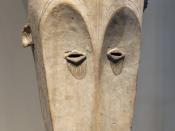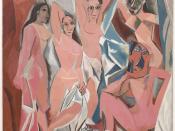Comparative Analysis of Les Demoiselles d'Avignon and The Dance
The Les Demoiselles d'Avignon (1907, Museum of Modern Art, New York), is an oil on canvas painting by Pablo Picasso. This is an image of five nudes grouped around a still life. Of the five figures, four of the figures are facing the viewer. There is a disjunction in the fifth figure as she is crouched on the floor, her back away from the viewer, while her face, or mask, addresses the viewer. This vertically aligned painting measures 8'x7'8" and was painted after the Blue and Rose periods. The Dance (First Version, 1909, Museum of Modern Art, New York), is an oil on canvas painting by Henri Matisse. This is an image of five nude women linking arms in an oval. This horizontally aligned painting measures 8'6"x12'9". This painting lacks detail and complexity. The artist has used four colors throughout the painting.
These colors are green, pink, black and blue.
Picasso painted Les Demoiselles d'Avignon after a notorious place of prostitution. The viewer is both attracted to the advances of the demoiselles, yet at the same time, recoiled with the horror of these prostitutes. This art belongs to a style of art known as Cubism. The savage, inhuman heads of the figures are the direct result of Picasso's recent exposure Iberian art from the sub-Saharan, Western African region. The emphasis on abstraction, flatness and angularity prevalent in the painting are attributes of Iberian art. Through this painting Picasso has lost the interest of naturalistic curves of the anatomy and has chosen to create planes. The figures seem flat, two-dimensional and weightless. We can divide the painting into portions, i.e., the three-fifths on the left and the two-fifths on the right. The left hand portion relates to the colors of...


